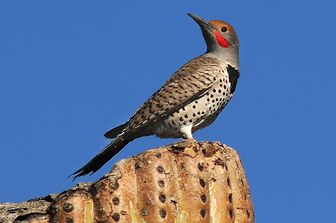Gilded Flicker
The Gilded Flicker most frequently builds its nest hole in a majestic saguaro cactus. Northern Flickers, on the other hand, nest in riparian trees and very rarely inhabit saguaros. Gilded Flickers occasionally hybridize with Northern Flickers in the narrow zones where their range and habitat overlap.

Original source: Glenn Seplak from Tucson, Arizona
Author: Glenn Seplak from Tucson, Arizona
The Gilded Flicker is classified as Least Concern. Does not qualify for a more at risk category. Widespread and abundant taxa are included in this category.
The Gilded Flicker (Colaptes chrysoides) is a large-sized woodpecker (mean length of 29 cm (11 in)) of the Sonoran, Yuma, and eastern Colorado Desert regions of the southwestern United States and northwestern Mexico including all of the Baja Peninsula except the extreme northwestern region. Golden yellow underwings distinguish the Gilded Flicker from the Northern Flicker found within the same region, which have red underwings. More
Gilded Flicker: Three to five white eggs are laid in a tree or cactus cavity, utility pole, or birdhouse. Incubation ranges from 11 to 14 days and is carried out by both parents. Foraging and Feeding Gilded Flicker: Eats insects, wild berries, and cactus fruits; forages on the ground. Readily Eats Suet, Sunflower Seed, Nuts, Sugar Water, Fruit Vocalization Gilded Flicker: Song is a bold, repetitive "wick-er. More
auratus), the Gilded Flicker was recognized as a full species prior to 1973 and again in 1995. The reasons for the split include the rarity of interbreeding with other flickers, a distinct appearance, a separate range, and the Gilded Flicker's adaption to a desert environment. Few details of its life history have been described. Appearance: The Gilded Flicker is a medium-large, conspicuous bird, often seen on the ground. The back is light brown with black, horizontal barring. More
nesting success of the Gilded Flicker in saguaro cactus, even though the two birds compete for nest holes. * In the 1960s, taxonomists grouped the Gilded Flicker with the Red-shafted and Yellow-shafted flickers as a single species, the Northern Flicker, in recognition of the extensive interbreeding of the forms. More
Sonoran Desert, the Gilded Flicker has the gray face and red mustache of the "red-shafted" form of the Northern Flicker, but the yellow wings of the "yellow-shafted" form. More
Bent Life History for the Gilded Flicker - the common name and sub-species reflect the nomenclature in use at the time the description was written. CAPE GILDED FLICKER COLAPTES CHRYSOIDES CHRYSOIDES (Malherbe) HABITS Because Maiherbe's name was given to the first gilded flicker to be described, and because his type came from the Cape region of Baja California, this race becomes the type race of the species. Its range extends from about latitude 28~ N. More
the Gilded Flicker now has status as a full species. Thought to be non-migratory, the Gilded Flicker occupies cactus forests and is known to frequently forage on the ground. Perhaps to beat the summer heat of the desert, Gilded Flickers tend to nest earlier in the year than Northern Flickers. While Northern Flickers have been known to live up to 9 years in the wild, there is little data regarding Gilded Flickers. (Follow the links on the left for additional information. More
(Colaptes auratus), the Gilded Flicker was recognized as a full species prior to 1973 and again in 1995. Gilded Flicker ( Nesting Female ) on Flickr - Photo ... Gilded Flicker ( Nesting Female ) Took this in my brother's yard on 9-26-07 . Comments. maia bird says: Wow, that's a flicker hole I haven't seen before. gilded flicker - definition of gilded flicker by the ... Thesaurus Legend: Synonyms Related Words Antonyms. Noun: 1. More
A gorgeous male yellow-shafted gilded flicker (woodpecker) feeding at my bird feeder, then he flies away! 1. Categories: Pets & Animals Comments on Yellow-Shafted Gilded Flicker - 0 Comments | Be the first to comment Enter your email to get daily video updates: 1. More
The Gilded Flicker is a year-round resident from southeastern California and central Arizona south into Mexico. It prefers Saguaro deserts, cottonwood-lined streams and towns. More information about the Gilded Flicker Visit Shaw Creek Bird Supply to see our selection of Flicker Houses. More
Gilded Flicker subspecies nests in saguaro cacti. The northern populations of flickers return to their breeding ground from mid-March to early April. A few weeks after their arrival, courtship begins. By late April and early May, pairs have bonded and begun to breed. The Northern Flicker will nest in boxes, but boxes should be packed tightly with sawdust for the birds to excavate. The more closely the nest box imitates a "punky" tree, the more desirable it will appear to Northern Flickers. More
Family : Picidae
Genus : Colaptes
Species : chrysoides
Authority : (Malherbe, 1852)
